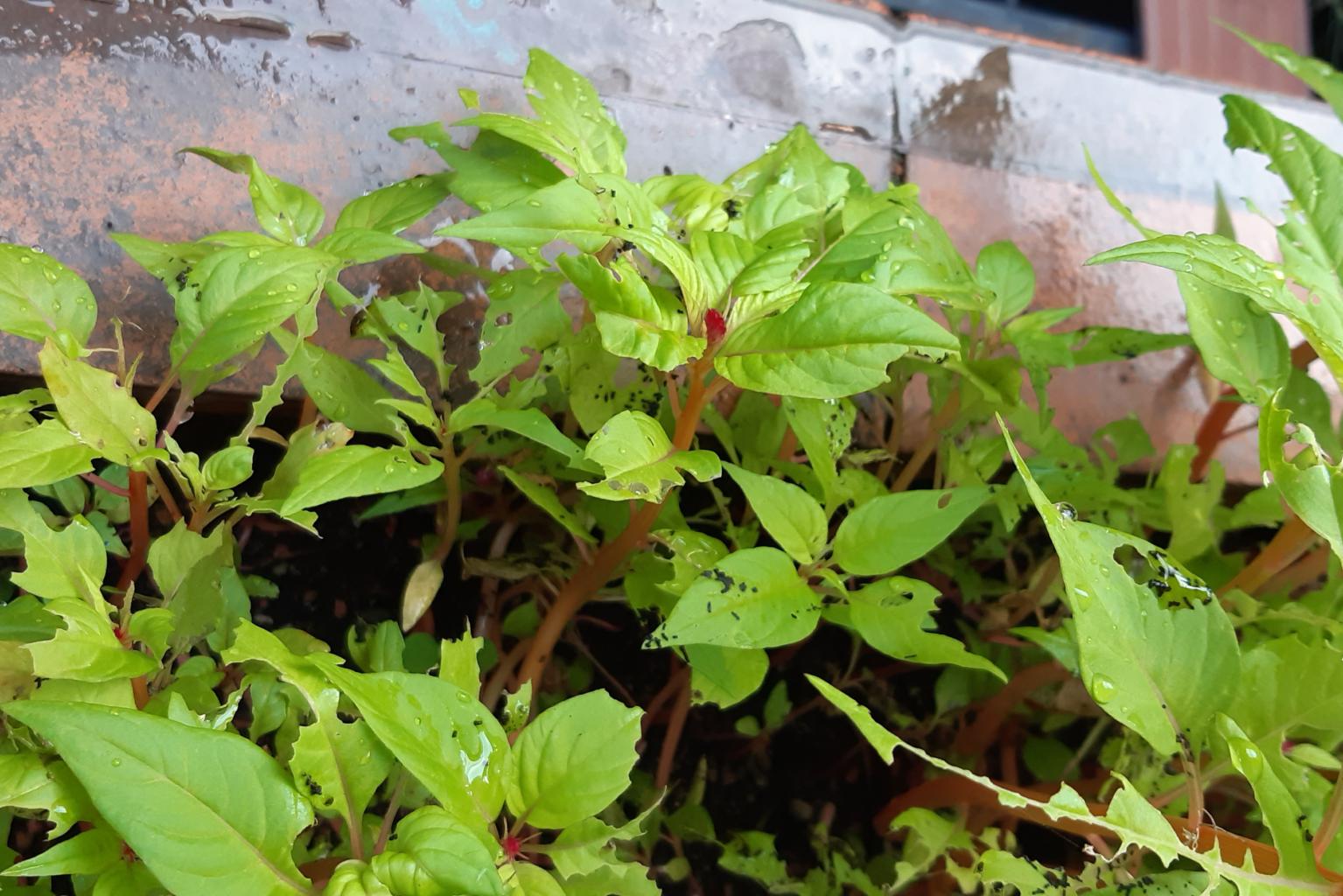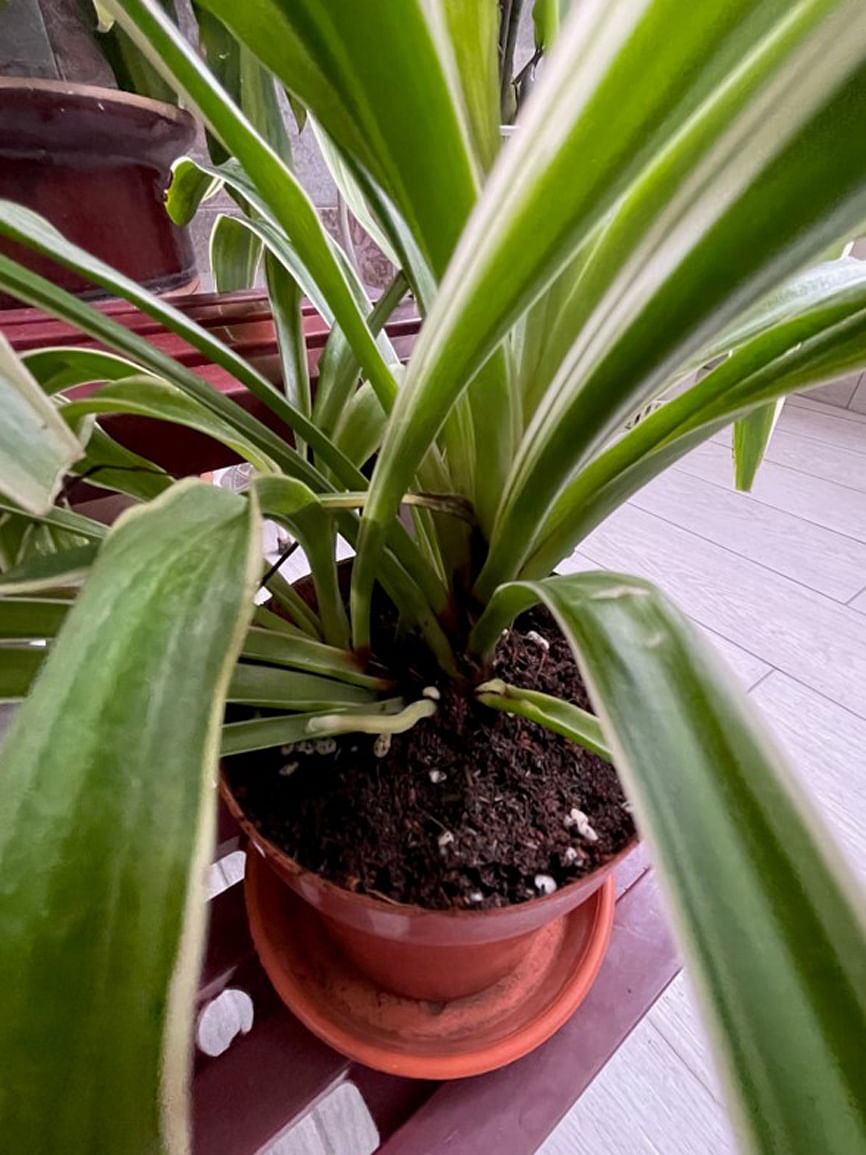Root Awakening: Caterpillar attack, succulent wax, mealy bug infestation
Sign up now: Get ST's newsletters delivered to your inbox

The cockscomb plant is being eaten by something that leaves behind soft, small black pellets.
PHOTO: LEONG WAI HIN LINDA
Follow topic:
Cockscomb plant attacked by caterpillars
My cockscomb is being eaten by something that leaves behind soft, small black pellets, which could be its faeces. I have sprinkled metaldehyde pellets around and under the plant to no avail. I rotate various pesticides weekly, such as dinotefuran granules, neem oil, malathion and Bacillus thuringiensis.
What pests could be affecting my plant and how do I get rid of them?
Leong Wai Hin Linda
The holes in the leaves and the small black pellets point towards a caterpillar infestation. Inspect the plants closely and look under the leaves to find the caterpillars. They can be manually picked off and destroyed.
An effective insecticide for caterpillars is Bacillus thuringiensis subspecies kurstaki (Btk), which goes by the product name Dipel. Make sure you use the right subspecies. This works best for smaller and younger caterpillars. Re-apply after rain as the insecticide would have been washed away. Another pesticide you can consider is abamectin, which has longer residual activity.
Succulent's wax is natural

root03-ol - Succulent - Medha Karthikeyan
PHOTO: Medha Karthikeyan
I bought this succulent plant for Teachers' Day and notice powdery white wax on it. Is this normal? Also, how do I care for the plant?
Medha Karthikeyan
The white coating is the succulent's natural wax, which helps reduce excessive water loss and harmful effects from intense sunlight. There is no need to remove the coating from the leaves.
In an apartment setting, place the plant on the windowsill or balcony, where it can be exposed to direct sunlight for at least four hours a day. A lack of light will lead to stretched, lanky plants with poor colour.
You may need to remove the peat-based media and repot the plant in well-drained, aerated media such as one consisting of pumice and fine expanded clay pellets. Water the plant thoroughly after doing so and water again after letting the media dry out slightly.
Ludovia Lancifolia popular among collectors

root03-ol - Ludovia lancifolia - Ingrid Lim
PHOTO: Ingrid Lim
I bought this plant from a nursery two months ago and placed it on a balcony which faces the east and is windy at times. I water it once a day, but it does not seem to be flourishing. What is this plant, why are there brown spots on the leaves and why are the leaf blades splitting at the ends?
Ingrid Lim
The plant you have is botanically known as Ludovia lancifolia. It is not commonly available for sale in local nurseries and is popular among plant collectors for its interesting growth form and attractive leaves.
This plant grows best when it receives at least four hours of filtered sunlight a day. Its leaves may turn a pale green and develop sunburn - which appears as brown patches - when grown under intense sunlight. It should also be protected from strong winds. The tears in the leaves could be due to the damaging effects of wind in its current location.
Lady's finger plant infested with mealy bugs

root03-ol - Lady's finger plant - Ling Hue Chye
PHOTO: Ling Hue Chye
My lady's finger plant has something white growing on it. What is it and what should I do? Is the plant still edible?
Ling Hue Chye
The fruit of your lady's finger plant is badly infested with mealy bugs, but it will still be edible once the bugs have been removed, if it is not too old and fibrous.
Your plant appears to be past its productive stage. You may want to start growing new plants from seeds.
Mealy bugs are sap-sucking pests that can weaken your plant. Infestations can be better controlled when they are still small. You can wash off these pests and then apply a pesticide like neem or summer oil, which suffocates them.
Repeated, thorough applications covering all parts of the plant are required to destroy the bugs and keep pest population low.
Observe the withholding period - that is, the time that needs to elapse after the application of the pesticide - before harvesting the fruit for consumption.
Spider plant may need more light and replanting

root03-ol - Spider plant - Cheong Yin Ping
PHOTO: Cheong Yin Ping
The new leaves of my spider plant have been turning yellow and curly. The roots are growing upwards, away from the soil. There are patches on the older leaves as well. How can I restore the plant to health?
Cheong Yin Ping
The new leaves of your spider plant appear to be pale green and floppy. It could be a response to low light conditions. Ensure your plant receives at least six hours of filtered sunlight a day. The lack of light can also lead to the appearance of fungal leaf spots.
Ensure your spider plant has not been planted too deeply. Soil around the plant's crown can lead to rot. Lift the plant slightly out of its growing media. If it is unstable, use a disposable chopstick to support the plant over time while it grows roots to anchor itself.
Keep the soil moist but not wet. Spider plants grow best in aerated, well-drained soil.
- Answers by Dr Wilson Wong, an NParks-certified practising horticulturist, parks manager and ISA-certified arborist. He is the founder of Green Culture Singapore and an adjunct assistant professor (Food Science & Technology) at the National University of Singapore.
- Have a gardening query? E-mail it with clear, high-resolution pictures of at least 1MB, if any, and your full name to stlife@sph.com.sg. We reserve the right to edit and reject questions.

